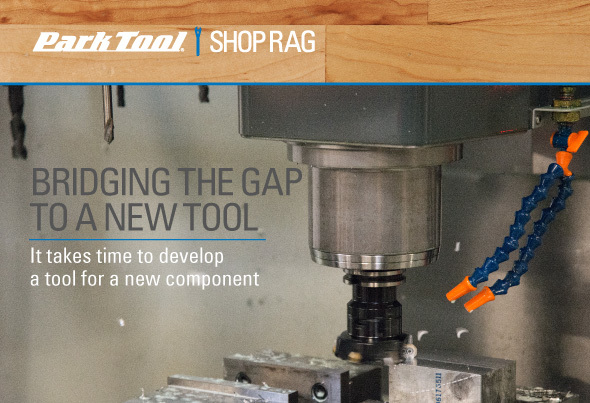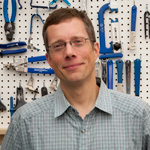Written by Alex on August 26, 2014/Shop Rag Newsletter
Shop Rag Issue 1 — Bridging the Gap to a New Tool

Let’s imagine that bike company XYZ has come out with a cool new component that requires a new tool. How does that new bike component give birth to a new, blue tool?
More often than not we have to wait, just like you, until we can actually buy this new super cool component. Once we acquire this new component, which is sure to change the world and how we all ride our bikes, we roll up our sleeves and begin the long process of reverse engineering a tool. We look at things like: What is this part made out of? How will it be attached or fit to the bike and interact with other components? What are the torque specs? And on and on…
Once we answer all of the key variables, we set about determining the best material for our new Park Tool. Some tool makers like to paint with broad-brush strokes: “We through harden everything we make!” or “Every tool is made from paper mache.” Well, if only the world were that simple. We are in the business of making the best tools and not creating the best marketing spin. The truth is that one material is never the best for all tools. Nor is a single type of heat treating or plating on the surface of the metal always the best for all tools. We prefer to design with a razor sharp engineer’s pen and a blank page for every new tool rather than a wide marketing paint brush. We evaluate each tool and its intended purpose on its own merits, and refuse to be hemmed in by a tag line in an ad or catalog or by using the easiest material to buy and fabricate.
So, we’ve set all of these big picture specifications and the real fun begins. The engineers begin modeling the new tool using 3D software. Now, we are a very picky group so this isn’t as straight forward as it sounds. Even simple tools will be morphed and changed during multiple rounds of revisions, re-drawing and testing. Not sure how it will feel in your hand by looking at the screen? Off to the 3D printer it goes so we have an actual tool to hold and to test the fit on an actual bike component. This process is a long and twisting yellow brick road but at this point we can begin to see the light at the end of the tunnel.
Once the design has survived the multiple layers of developmental hazing and revisions, we begin to lay the plans for production. Purchasing, production and marketing departments are now called to action. Raw materials are ordered, production and packaging is planned, instructions are written and web and catalog space is prepared.
All of these stars come into alignment as tools roll down the production line, out the door to distributors and, ultimately into your hands.
While it would be nice to have a new component hit the market and with just a snap of our fingers there is a new tool that appears, that just isn’t meant to be. And that is okay. Why? Because we’re proud of every tool we make. We think that all of the careful thought we put into each and every step of each tool’s development shows through even in our instant gratification society. It’s that deliberate process that is part of the fun. The process of turning out new Blue tools that help you enjoy your ride…
 About the Author: John Krawczyk is integral to pushing forward the product development process in his role as Project Manager at Park Tool. He has more than 20 years of industry experience having worked for Granite City Schwinn, Trek, Planet Bike and the last 14 years at Park Tool. He’s also a bike mechanic, retired baseball coach and regular bike commuter.
About the Author: John Krawczyk is integral to pushing forward the product development process in his role as Project Manager at Park Tool. He has more than 20 years of industry experience having worked for Granite City Schwinn, Trek, Planet Bike and the last 14 years at Park Tool. He’s also a bike mechanic, retired baseball coach and regular bike commuter.
